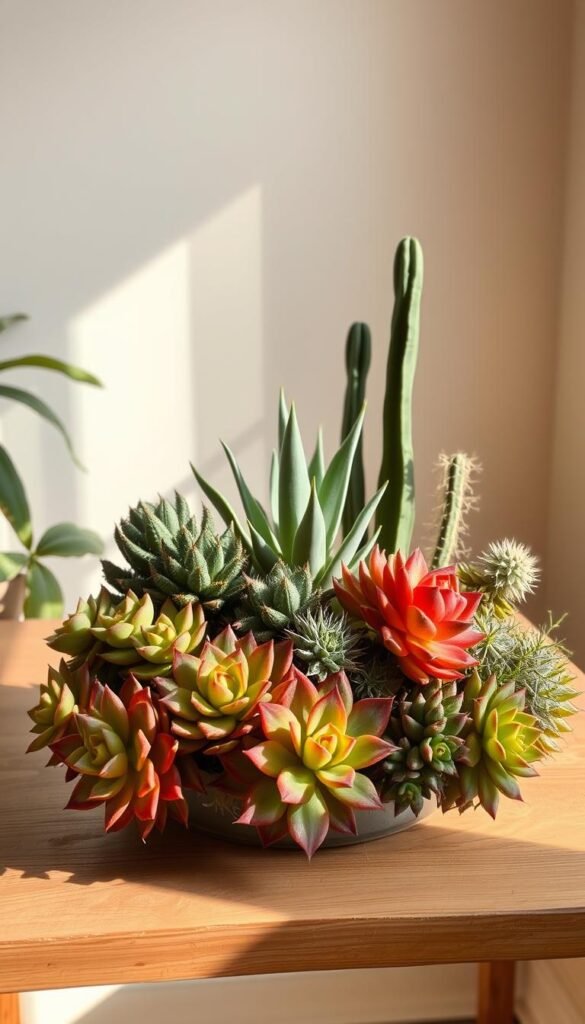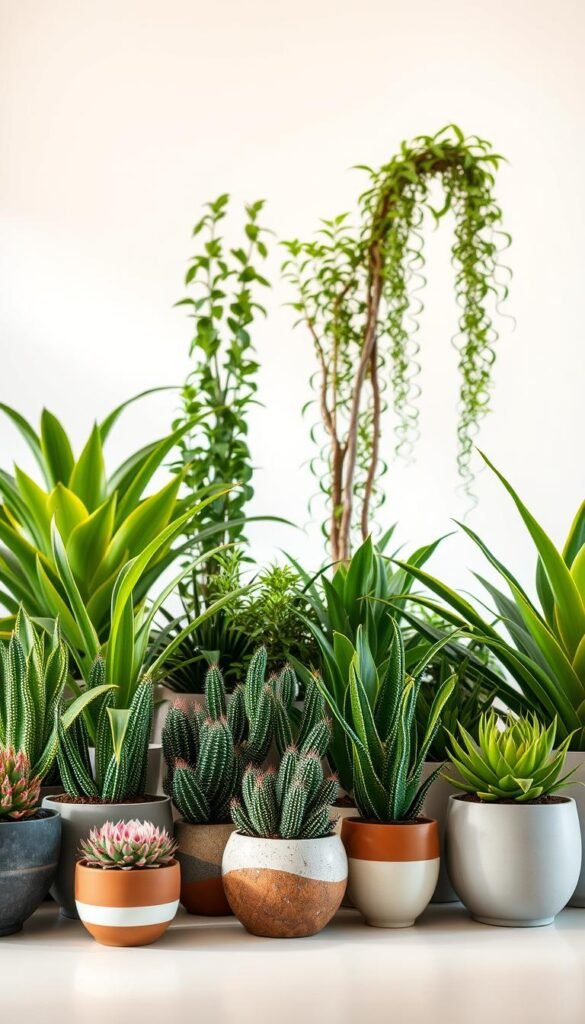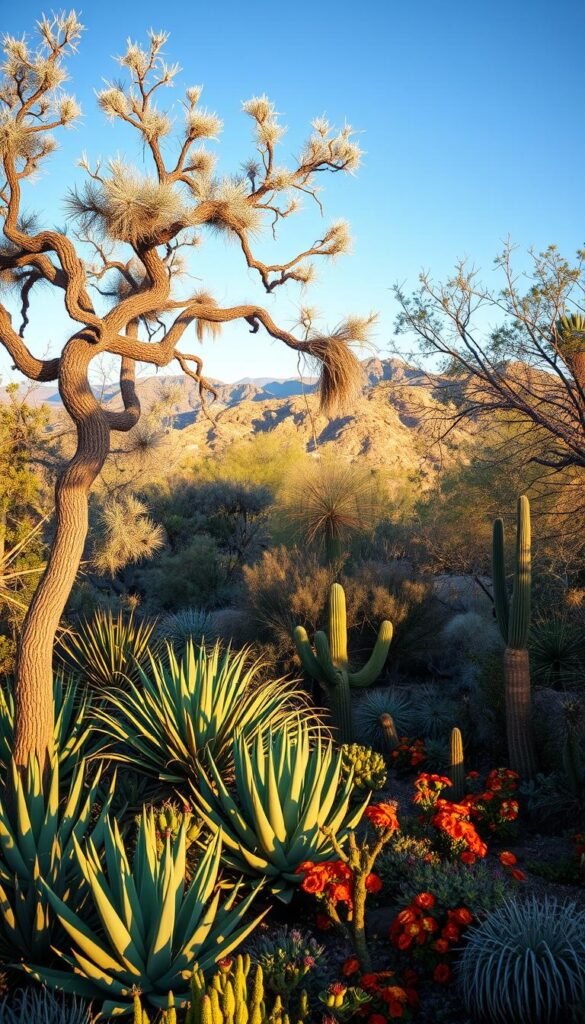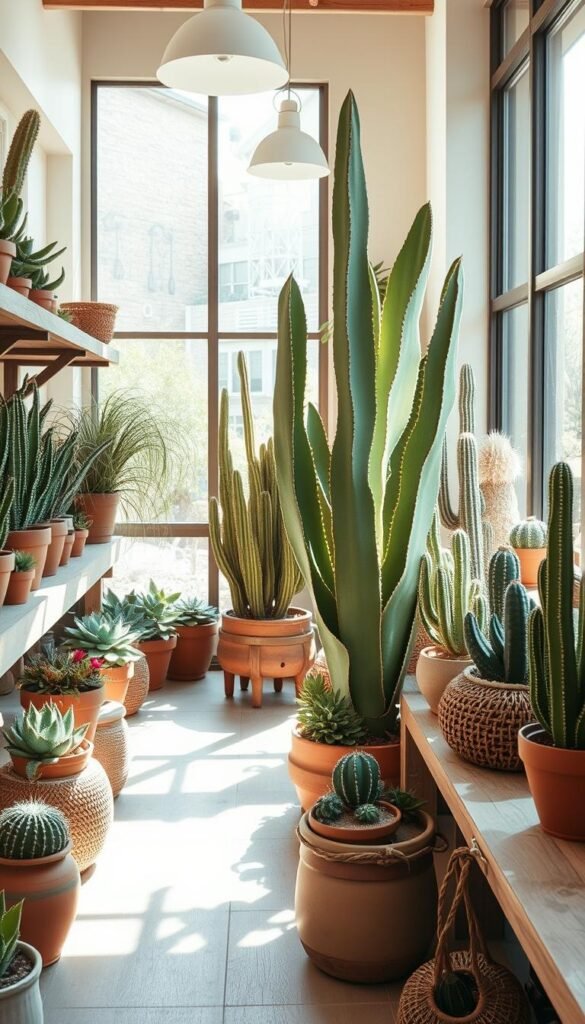Imagine bringing the striking beauty of arid landscapes into your living space while slashing your water usage. Drought-tolerant species like cacti and succulents offer more than just survival skills—they bring sculptural shapes and unexpected pops of color to your home. These resilient varieties evolved in harsh environments, developing clever ways to store moisture in their leaves, stems, and roots.
You’ll find that creating a low-maintenance display requires minimal effort once you understand these plants’ natural rhythms. Their unique textures—from spiky agaves to velvety kalanchoes—add depth and intrigue to any room. Many species bloom seasonally, surprising you with vibrant flowers that contrast beautifully against their rugged forms.
What makes these specimens truly special is their ability to thrive with scarce resources. Deep-rooted varieties like yucca mimic their wild counterparts by seeking moisture efficiently. This biological ingenuity means you can enjoy lush greenery without constant watering or complicated care routines.
By embracing these adaptive species, you’re not just decorating—you’re crafting a living tribute to nature’s resilience. Every spiny silhouette and fleshy leaf tells a story of survival, transforming your space into a conversation-starting sanctuary. Best of all, you’ll join a growing movement toward sustainable living without sacrificing style.
Embracing the Dry Garden Indoor Lifestyle

Adopting a low-water lifestyle indoors doesn’t mean compromising on greenery or style. Studies reveal outdoor irrigation accounts for 80% of urban water use in regions like California’s Coachella Valley. By bringing this conservation mindset inside, you’ll join a movement reshaping how we nurture plants in living spaces.
Smart grouping of specimens with similar hydration needs creates thriving displays. Velvety kalanchoes might share space with spiky euphorbias, both sipping moisture sparingly. This strategic pairing mirrors natural desert communities where survival depends on resource sharing.
Your home becomes a showcase of resilience as these drought-adapted varieties reveal hidden talents. Stone-like lithops burst into daisy-like blooms, while trailing sedums cascade like living jewelry. You’ll discover more textures and colors than typical houseplants offer.
The benefits extend beyond aesthetics. Properly arranged collections need watering just monthly—some thrive on mere humidity. You’ll save approximately 80% on hydration compared to traditional gardening approaches, according to water conservation studies.
Connect with fellow enthusiasts through local plant swaps or online communities. Share propagation tips for jade plants or debate the best soil mixes for prickly pear cacti. Every shared success story strengthens our collective environmental stewardship.
Dry Garden Indoor: Desert-Inspired Designs for Minimal Water Use

Harness the power of desert evolution to craft stunning, low-maintenance interiors. Desert plants perfected survival over millennia, developing features like waxy leaf coatings and silver-toned foliage to reflect harsh sunlight. These natural adaptations make them ideal for homes where watering is infrequent.
You’ll notice how native plants from arid regions thrive in lean, rocky soil—a feature you can replicate indoors. Mix gritty sand or perlite into potting mixes to mimic their natural growing conditions. This approach prevents root rot and supports species like agave, which store moisture in their fleshy leaves.
Three key design principles elevate your space:
- Textural contrast: Pair spiny cacti with smooth river stones
- Strategic placement: Group plants by sunlight needs near south-facing windows
- Color echoes: Use terracotta pots to mirror desert climate tones
For urban spaces, consider container setups that showcase trailing sedums alongside upright euphorbias. Their shallow root systems adapt well to limited soil depth while creating striking vertical interest.
By understanding these survival strategies, you create displays that need water only every 3-4 weeks. Your home becomes a living exhibit of nature’s ingenuity—where beauty meets resourcefulness.
Understanding the Benefits of Minimal Water Use at Home

Transforming your living space into an eco-friendly haven starts with smart water choices. Research reveals that strategic placement of plants can slash cooling costs by up to 42%, acting as natural air conditioners through evapotranspiration. This process cools surrounding air as moisture evaporates from leaves—no sprinklers required.
Ground covers outperform gravel landscapes in heat reduction, shielding walls and windows from solar gain. You’ll notice lower energy bills year-round as these living systems work passively. Even better? Drought-resistant varieties need watering just 20% as often as traditional greenery.
Three financial perks stand out:
- Reduced utility expenses from natural temperature regulation
- Minimal spending on fertilizers and soil treatments
- Long-term savings through healthier, disease-resistant plants
Your water-wise approach does more than save money—it protects local resources. Every gallon conserved supports community reserves while showcasing sustainable living. Neighbors might even ask for cuttings from your thriving specimens!
These resilient species naturally avoid root rot and fungal issues common in overwatered environments. You’re not just growing greenery—you’re cultivating a legacy of conservation that flourishes with every drop saved.
Planning Your Indoor Desert Oasis

Transform your space into a thriving ecosystem by mastering light and heat patterns. Start by mapping sunlight exposure across rooms—track how rays shift from morning to evening. South-facing windows receive intense midday glare, while west exposures bake plants with afternoon intensity.
Choosing the Right Location
Identify microclimates near windows or heating vents where temperatures fluctuate. Shelves 3-5 feet from south windows suit sun-loving agaves. North-facing nooks work for haworthias needing gentle light. Avoid placing sensitive species where reflected heat from glass or walls could scorch leaves.
Lighting and Ambience Considerations
Use sheer curtains to soften harsh summer rays without blocking vital sunshine. Rotate pots weekly so all sides get equal exposure. Pair trailing plants like rhipsalis with upright cacti near bright windows—their contrasting forms catch light beautifully.
Architectural elements matter too. A bookshelf’s shade protects lithops during peak sunlight hours. White walls bounce light deeper into rooms, creating ideal conditions for clustered arrangements. Monitor seasonal changes—winter sun angles might require moving specimens closer to windows.
Selecting Drought-Tolerant Trees and Shrubs

Elevate your space with woody plants that thrive on neglect. Species like mesquite and yucca evolved taproots reaching 30+ feet underground—nature’s blueprint for surviving dry spells. These deep root systems make them ideal candidates for containers, where limited watering mimics their natural habitat.
Deep Root Systems and Native Plant Benefits
Native plants like creosote bush outperform imports because they’re fine-tuned to arid conditions. Their branching patterns and leaf structures minimize moisture loss while maximizing photosynthesis. You’ll notice multi-trunk specimens handle indoor airflow better than single-stem varieties.
Three traits define winners for your collection:
- Twisted trunks that add sculptural drama
- Waxy or hairy leaves reducing evaporation
- Slow growth rates needing less pruning
Proven performers include Mulga Acacia with its silvery foliage and Bottle Tree’s swollen trunk storing moisture. Coolibah trees adapt beautifully to pots, their roots self-regulating to container depth. Pair these with smaller shrubs like desert lavender for layered textures.
Remember—even drought-hardy trees shrubs need proper drainage. Use coarse substrates mimicking rocky soils to prevent soggy roots. With smart choices, you’ll create a living sculpture garden that sips water monthly.
Incorporating Succulents and Cacti for Unique Textures
Transform your space with living sculptures that thrive on neglect. Succulents and cacti evolved water-storing superpowers, hoarding moisture in plump leaves, stems, and roots. Their survival skills become your design toolkit, offering shapes from spiky orbs to cascading rosettes.
Discover 250 agave varieties sporting blue-gray foliage or striped patterns. Pair them with aloe’s 650 species—some towering like trees, others fitting in teacups. These plants turn survival into art through ribbed textures and geometric precision.
Create visual drama by mixing forms. Smooth agave blades contrast with fuzzy kalanchoe leaves. Spiral-aligned haworthias echo modern decor, while barrel cacti add bold curves. Their architectural shapes demand attention without crowding shelves.
Watch colors shift with seasons and light. Jade succulents blush ruby-red near sunny windows. Blue chalksticks develop lavender edges, while moonstones glow pearly pink. These subtle changes keep displays dynamic year-round.
Care becomes effortless once roots establish. Water deeply but rarely—every 3-4 weeks suffices. Use gritty soil mimicking native habitats, and watch your collection flourish. Each sculptural form tells a story of adaptation, turning shelves into conversation-starting galleries.
Pairing Agave, Aloe, and More for Visual Interest
Create eye-catching displays by mixing structural giants with petite companions. Agave’s geometric forms shine when paired with aloe’s softer silhouettes, turning shelves into living art galleries. Their contrasting textures and growth habits add depth to any room.
| Feature | Agave | Aloe |
|---|---|---|
| Mature Height | 1-20 feet | 6 inches-30 feet |
| Leaf Texture | Stiff, pointed | Fleshy, serrated |
| Water Needs | Every 4 weeks | Every 3 weeks |
Using Agave as a Striking Focal Point
Position larger agave varieties like the 6-foot plants near entryways or empty corners. Their sword-like leaves create instant drama. Smaller types (1-3 feet tall) work beautifully on console tables, their symmetrical shapes balancing modern decor.
Caring for Indoor Aloe and Similar Species
Give aloe bright light and gritty soil for healthy roots. Water only when soil dries completely—overwatering causes rot. Watch for winter blooms: torch-shaped flowers add unexpected color when most plants rest.
Pair spiky specimens with round succulents like echeveria. The contrast keeps displays lively year-round. Remember: match pot sizes to mature dimensions. A 10-foot agave needs space for its roots, while compact aloes thrive in shallow bowls.
Understanding Soil, Mulches, and Moisture Management
The secret to thriving desert plants starts beneath the surface. Native arid soils often contain high levels of calcium and sodium, creating alkaline conditions. You can mimic these soil properties while improving drainage by mixing gritty sand with crushed granite. This approach prevents root rot while letting roots breathe.
Organic amendments work wonders without waterlogging. Try blending composted bark with aged manure at a 3:1 ratio. These materials boost moisture retention during dry spells while keeping the ground structure loose. Your plants get nutrients without soggy roots.
| Mulch Type | Key Benefit | Best For |
|---|---|---|
| Ground Bark | Prevents crusting | Shallow-rooted cacti |
| Cottonseed Hulls | Regulates temperature | Seedlings |
| Composted Sawdust | Suppresses weeds | Mature specimens |
Mulching does more than look neat—it cuts watering needs by 40% in summer. Spread a thin layer (1-2 inches) around plants, keeping it away from stems. You’ll notice healthier growth as the soil stays cooler and more stable.
Test drainage after planting by watering deeply. If puddles form, add more perlite. For moisture-sensitive species like lithops, use extra gravel in your mix. With the right balance, your plants will flourish on minimal care.
Creating an Indoor Rock Garden and Xeriscape
Rocks become living art when paired with resilient plants in your home. Strategic stone placement does more than mimic natural landscapes—it creates microclimates where roots stay protected. Moisture naturally collects around boulders, releasing humidity slowly to nearby specimens.
Selecting Rocks and Hardscape Elements
Choose porous stones like lava rock or sandstone for better heat distribution. These materials absorb warmth during the day, then radiate it at night—perfect for species needing stable root temperatures. Stacked slate pieces make excellent terraced beds, directing water flow while adding visual depth.
Inspired by the Ruth Bancroft Garden, blend angular granite with smooth river pebbles. This contrast highlights your plants’ textures while improving drainage. Larger rocks work as natural mulch, reducing evaporation in shallow containers.
Three principles guide successful arrangements:
- Match stone colors to your plants’ hues—rust-toned rocks complement blue-green succulents
- Create elevation changes with flat flagstones for cascading species
- Leave gaps between stones for root expansion and air circulation
Your rock garden becomes a self-regulating ecosystem. Heat-retaining stones reduce watering needs, while elevated beds prevent soggy soil. Every element works together—beauty and function united.
Efficient Irrigation and Water-Saving Techniques
Mastering smart hydration methods transforms how you nurture resilient greenery. Drip systems deliver moisture directly to roots, encouraging deeper growth while preventing surface evaporation. This approach mirrors natural rainfall patterns, teaching your plants to develop robust root networks.
Deep watering sessions every 3-4 weeks prove more effective than frequent sprinkles. Let the water penetrate through well-draining soil mixes, carrying away excess salts from alkaline substrates. You’ll notice healthier specimens as roots learn to seek hydration efficiently.
Seasoned growers condition their collections to handle temperature swings. Gradually expose plants to warmer spots near windows, building tolerance to dry air currents. Established specimens thrive when you resist the urge to overwater—soggy soil invites more trouble than drought.
Smart systems like timed emitters or self-watering pots maintain ideal moisture levels. Pair these with moisture meters to eliminate guesswork. Your reward? Vibrant growth that uses 75% less water than conventional methods, according to urban conservation studies.
Remember: parched-looking soil often means your plants are building character. Wait until the top inch feels bone-dry before replenishing. This discipline creates self-sufficient greenery that beautifies your space while honoring Earth’s precious resources.






